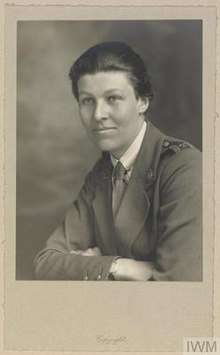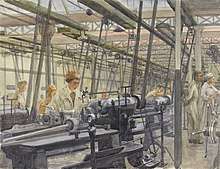Beatrice Ethel Lithiby
Beatrice Ethel Lithiby (4 December 1889- 25 July 1966) was a British artist known as a painter and designer of stained glass and church furnishings. She served in both World War I and World War II in the British Army and in the former conflict also worked as a war artist for the Imperial War Museum.
Beatrice Ethel Lithiby | |
|---|---|
 Lithiby c.1918 | |
| Born | 4 December 1889 Richmond, Surrey |
| Died | 25 July 1966 (aged 76) |
| Nationality | British |
| Education | Royal Academy Schools |
| Known for | Painting, stained glass, church furnishings |
| Awards | MBE, OBE |
Biography
Lithiby was born at Richmond, then in Surrey and now in London, the daughter of John Lithiby (1853-1936), a barrister, and Ethel Stewart née Smith (1860-1943).[1] Lithiby studied at the Royal Academy Schools.[2] As a student she was due to become engaged to a fellow student, Frank Skinner, when he returned from military service but he was killed in July 1916 on the Somme and Lithiby would mark the anniversary of his death each year with a notice in The Daily Telegraph.[3]
During World War I, Lithiby served as a Unit Administrator in Queen Mary's Army Auxiliary Corps, QMAAC, in France for eighteen months.[4] In February 1919 she approached the Women's Work Committee of the Imperial War Museum with an offer to record the activities of the QMAAC members remaining in France before their units were disbanded and they returned home.[4] The Committee agreed to her proposal and Lithiby spent a further six months in France recording, in sketches and watercolour paintings, the work of the QMAAC at camps in Dieppe, Rouen, Le Havre and Abbeville where the Corps' members were tending cemeteries, clearing former battlefields and performing other industrial and administrative roles.[4] Although Lithiby had initially agreed a greatly reduced fee with the Committee, three months into her commission the Committee wrote to her to say that due to budget cuts they would be unable to pay her at all.[4] Lithiby continued with the work and in due course donated twenty watercolours to the Imperial War Museum which form a rare artistic record of the work of women in military service at the time.[4]

From 1920 to 1939, Lithiby worked as a figure and landscape painter and muralist. She regularly exhibited at both the Royal Academy and the Royal Society of British Artists and was elected a member of the latter in 1930.[2] She also exhibited with the Society of Women Artists, the Royal Institute of Painters in Water Colours and at Walker's Galleries.[3]She completed commissions for stained glass windows and church furnishings both in Britain, in Japan and South Africa.[4][3]
For many years Lithiby lived at Wantage in Berkshire.[2] Her home and studio were in the grounds of an Anglican convent, St Mary's, and Lithiby was a devout Christian.[3] She compiled a history book about Wantage parish church. [3] During World War II, Lithiby rejoined the British Army and rose to a senior rank.[3] She was awarded the MBE and later the OBE.[1] She died in 1966 on the 50th anniversary of the death of Frank Skinner.[3]
See also
References
- "Lithiby, Beatrice Ethel". Suffolk Artists. Retrieved 2 May 2019.
- Grant M. Waters (1975). Dictionary of British Artists Working 1900-1950. Eastbourne Fine Art.
- David Buckman (2006). Artists in Britain Since 1945 Vol 1, A to L. Art Dictionaries Ltd. ISBN 0 953260 95 X.
- Catherine Speck (2014). Beyond the Battlefield, Women Artists of Two World Wars. Reaktion Books. ISBN 978 178023 374 1.
External links
| Wikimedia Commons has media related to Beatrice Ethel Lithiby. |